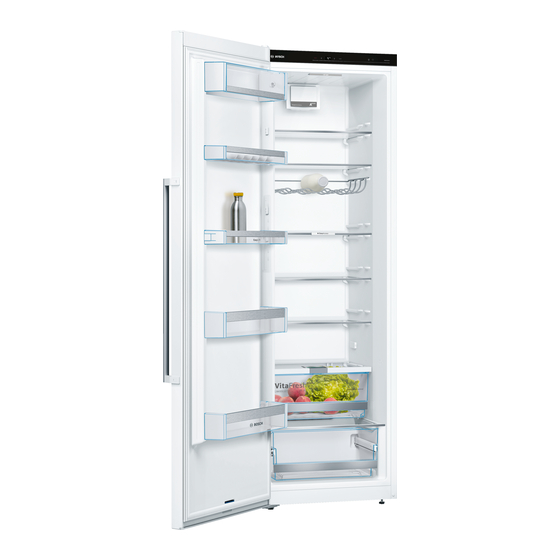Bosch KSV36AW4PG Instructions For Use Manual - Page 11
Browse online or download pdf Instructions For Use Manual for Refrigerator Bosch KSV36AW4PG. Bosch KSV36AW4PG 22 pages.

To retain aroma, colour
■
and freshness, pack or cover food
well before placing in the appliance.
This will prevent the transfer
of flavours and the discolouration
of plastic parts in the refrigerator
compartment.
Allow warm food and drinks to cool
■
down before placing in the appliance.
Note
Avoid contact between food and rear
panel. Otherwise the air circulation will
be impaired.
Food or packaging could freeze to
the rear panel.
Note the chill zones
in the refrigerator
compartment
The air circulation in the refrigerator
compartment creates different chill
zones:
Coldest zone is between the arrow
■
stamped on the side and the glass
shelf situated below. Fig. %
Note
Store perishable food (e.g. fish,
sausage, meat) in the coldest zone.
Warmest zone is at the very top
■
of the door and in the lower vegetable
container.
Note
Store at the very top of the door e.g.
hard cheese and butter. Cheese can
then continue to release its flavour
and the butter will still be easy
to spread.
Vegetable container with
humidity control
Fig. &
To create the optimum storage climate
for fruit and vegetables, you can set
the humidity level in the vegetable
container:
Mainly vegetables as well as for a
■
mixed or small load – high air
humidity
Mainly fruit as well as for a large load
■
– low air humidity
Notes
Fruit sensitive to cold (e.g. pineapple,
■
banana, papaya and citrus fruit) and
vegetables sensitive to cold (e.g.
aubergines, cucumbers, zucchini,
peppers, tomatoes and potatoes)
should be stored outside
the refrigerator at temperatures
of approx. +8 °C to +12 °C for
optimum preservation of quality and
flavour.
Condensation may form in the
■
vegetable container depending on the
type and quantity of products stored.
Remove condensation with a dry cloth
and adjust air humidity in the
vegetable container with the humidity
controller.
en
11
